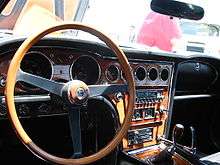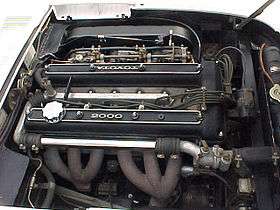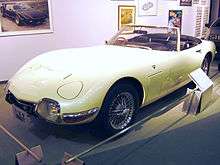Toyota 2000GT
The Toyota 2000GT is a limited-production, front-engine, rear-wheel-drive, two-seat, hardtop coupé grand tourer designed by Toyota in collaboration with Yamaha. First displayed to the public at the Tokyo Motor Show in 1965, the 2000GT was manufactured under contract by Yamaha between 1967 and 1970. A halo car for the automaker, in Japan it was exclusive to Toyota's Japanese retail sales channel called Toyota Store.
| Toyota 2000GT (MF10) | |
|---|---|
 | |
| Overview | |
| Manufacturer | Toyota Motor Corporation and Yamaha Motor Corporation (joint project) |
| Production | 1967–1970 (351 produced) |
| Designer |
|
| Body and chassis | |
| Class | Sports car/grand tourer |
| Body style | 2-door fastback |
| Layout | Front mid-engine, rear-wheel-drive |
| Powertrain | |
| Engine | |
| Power output |
|
| Transmission | |
| Dimensions | |
| Wheelbase | 2,320 mm (91.3 in) |
| Length | 4,175 mm (164.4 in) |
| Width | 1,600 mm (63.0 in) |
| Height | 1,160 mm (45.7 in) |
| Curb weight | 1,120 kg (2,469 lb) |
The 2000GT revolutionized the automotive world's view of Japan, then viewed as a producer of imitative and stodgily practical vehicles. As a sleek, high-performance fastback, it demonstrated its auto makers could produce a sports car to rival the better marques of Europe. Reviewing a pre-production 2000GT in 1967, Road & Track magazine summed up the car as "one of the most exciting and enjoyable cars we've driven", and compared it favorably to the Porsche 911. Today, the 2000GT is seen as the first seriously collectible Japanese car and its first supercar. Examples of the 2000GT have sold at auction for as much as US$1,200,000.[2]
Background
Most of the 2000GT's design was done by Yamaha, which also did much automobile work for other Japanese manufacturers, originally for Nissan rather than Toyota. A prototype 2000GT was built, but Nissan declined. Yamaha then proposed the design to Toyota, for whom they also did contract work, then perceived as the most conservative of the Japanese car manufacturers. Wishing to improve their image, Toyota accepted the proposal, but employed a design from their own designer Satoru Nozaki.[3][4]
Styling

The 2000GT incorporated many classic 1960s gran turismo design elements. Nozaki's styling was inspired by the E-type Jaguar.[5] Its smoothly flowing bodywork was executed in aluminium and featured pop-up headlights above large plexiglass covered driving lamps flanking the grille similar to those on the Toyota Sports 800. Bumpers were minimal, and the car was extremely low, just 116 cm (45.7 in) to the highest point of the roof. Despite a custom open-top version built for the James Bond film You Only Live Twice, a factory-produced convertible was never offered.

The interior offered comfortable, if cramped, accommodation and luxury touches such as a rosewood-veneer dashboard and auto-seeking radio tuner. Road & Track was impressed, considering the interior suited to a "luxurious GT" and calling the 2000GT an impressive car "in which to sit or ride - or simply admire."
In 1969, the front was modified slightly, making the driving lamps smaller and changing the shape of the turn signals. The rear turn signals were enlarged at the same time, and some alterations were made to modernise the interior. The last few vehicles were fitted with air conditioning and had automatic transmission as an option. These cars had an additional scoop fitted underneath the grille to supply air to the A/C unit.
Drivetrain


The engine was a longitudinally mounted 1,988 cc (2.0 L; 121.3 cu in) straight-6 (the 3M) based on the engine in the top-of-the-line Toyota Crown sedan. It was transformed by Yamaha into a sports car engine by coupling three 2-barrel Mikuni-Solex 40 PHH carburetors[6][7] to a new DOHC head that produced 150 PS (148 bhp; 110 kW) at 6,600 rpm and 175 N⋅m (129 lb⋅ft) at 5,000 rpm of torque.
Nine special MF-12 models were also built with the larger but lower output SOHC 2.3 L 2M-B engine, which produced 140 PS (138 bhp; 103 kW) at 5,800 rpm and 201 N⋅m (148 lb⋅ft) at 3,800 rpm of torque.
Fitted with a five-speed manual transmission, the rear wheel drive car was available with three different final drives. A 4.375 ratio axle car was claimed to be capable of reaching 135 mph (217 km/h) and achieve 7.59 L/100 km (31 mpg‑US; 37 mpg‑imp).[8]
Both a limited slip differential and all-round power-assisted disc brake, a first for a Japanese car, were standard. The dashboard mounted emergency brake gripped the rear discs directly.
Production
Only 351 regular production units of the 2000GT were built, figures comparable to contemporary elite Italian supercars. Taking two years for production vehicles to finally emerge, a total of 233 MF10s, 109 MF10Ls, and nine MF12Ls were built by Yamaha according to Toyota and Yamaha data. In America, the 2000GT sold for about $6,800, much more than contemporary Porsches and Jaguars. As a “halo car” for Toyota, it is believed that no profit was made on the 2000GT despite its high price. About 60 units reached North America and the others were similarly thinly spread worldwide. Most 2000GTs were painted either red or white.
Racing
Toyota entered the 2000GT in competition at home, coming third in the 1966 Japanese Grand Prix and winning the Fuji 1000 Kilometres race in 1967. In addition, the car set several FIA world records for speed and endurance in a 72-hour test. Unfortunately, the record car was destroyed in a pace car accident and eventually scrapped. These records shortly prompted Porsche to prepare a 911R especially to beat this record.
Carroll Shelby also entered a pair of 2000GTs to compete in the 1968 SCCA production car races in the CP category. Initially Shelby built three cars, including one spare. Although it performed well, it was the only season the car competed in the US. Toyota took back one of the cars and rebuilt it into a replica of their record car, which still resides in Japan. The two remaining Shelby cars remain in the United States.
2000GT Open-Top, the "Bond Model"

The 2000GT made its most famous screen appearance in the 1967 James Bond movie You Only Live Twice, most of which was filmed in Japan. Two one-off topless models - fitted only with tonneau covers to simulate functioning convertible roofs - were made specially for the film. It is claimed a targa had been considered to accommodate the burly 6' 2" Sean Connery. This retained the original car's fastback profile but eliminated rear side windows. Purportedly, Connery's head stuck out of the top and a roofless version was fabricated in less than two weeks for the movie.[9] The car was mainly driven by Bond girlfriend Aki (Akiko Wakabayashi) in the film.[10]
Bond actor Daniel Craig voted the 2000GT as his favourite Bond car of all time.[11]
References
Notes
- Willson, Quentin (1995). The Ultimate Classic Car Book. DK Publishing, Inc. ISBN 0-7894-0159-2.
- "Wheelies: The Lavishly Expensive Roadster Edition". NY Times Wheels blog. 30 April 2013. Retrieved 30 April 2013.
- Branch, Jon (21 January 2019). "A Brief History of the Toyota 2000GT - Everything You Need To Know". Silodrome. US. Retrieved 8 October 2019.
- Ernst, Kurt (20 August 2015). "Stereotype shatterer: Toyota's first U.S. market 200". Hemmings Daily. US. Retrieved 8 October 2019.
- Vance, Brian; Markus, Frank (6 September 2005). "Head to head: 1969 Toyota 2000GT vs. 1965 Jaguar E-Type". Motor Trend. US. Retrieved 13 October 2016.
- "1968 Toyota 2000 GT MF10". carfolio.com. Retrieved 10 June 2018.
- "1967 -1970 Toyota 2000 GT specifications". ultimatecarpage.com. Retrieved 10 June 2018.
- Willson, Quentin (1995). The Ultimate Classic Car Book. DK Publishing, Inc. ISBN 0-7894-0159-2.
- Carlsson, Mårten (19 November 2019). "Toyotas filmbil". Klassiker (in Swedish). Sweden. Retrieved 22 November 2019.
- "You Only Live Twice- The James Bond International Fan Club". 007.info.
- "Toyota 2000GT is Bond's favourite Bond car". Toyota GB Blog. Toyota GB. Retrieved 11 February 2015.
Sources
| Wikimedia Commons has media related to Toyota 2000GT. |
- Yoshikawa, Shin (2002). Toyota 2000GT: The Complete History of Japan's First Supercar. K.A.I. Lebec, California U.S.A. ISBN 0-932128-10-6.
- Langworth, Richard M. (ed.) (2000). Complete book of collectible cars: 60 years of blue-chip auto investments. Gettysburg: Lincolnwood, Illinois: Publications International. ISBN 0-7853-0971-3.CS1 maint: extra text: authors list (link)
- "Lifelong Pursuit". Japanese Nostalgic Car. Archived from the original on 4 July 2007. Retrieved 2 January 2007.
- "2000GT opened doors internationally for Toyota". Chicago Sun-Times. Retrieved 22 August 2004.
- "REFLECTIONS: Toyota 2000GT marked Japan's rise in auto industry". London Free Press. Archived from the original on 22 August 2004. Retrieved 22 August 2004.
- Zimmerman, Martin (13 October 2007). "From econo-boxes to collectors' cars". Los Angeles Times. Archived from the original on 5 November 2007. Retrieved 15 October 2007.
- James T. Crowe (ed) (1968). "Toyota 2000 GT". Road & Track Road Test Annual: 110–113.CS1 maint: extra text: authors list (link)
- Top Gear episode "Bond Cars"